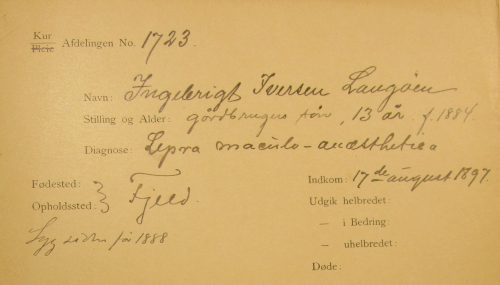The siblings Guri and Ingebrigt Langøen
At the end of the 1890s, a fishing and farming family from Langøen in Fjell in Øygarden outside Bergen were strongly impacted by leprosy. In 1897, the district medical officer applied for places in Pleiestiftelsen Hospital for the siblings Guri Botilde Iversdatter Langøen and Ingebrigt Kristoffer Iversen Langøen, aged 10 and 12 years old respectively, and their mother Guri Pedersdatter Langøen, aged 44 years old. They all had leprosy and were admitted to Pleiestiftelsen within a few years. The fact that several family members were often infected at the same time long fuelled the belief that leprosy was hereditary.
Hospitalisation
Ingebrigt and his mother arrived at Pleiestiftelsen on 17 august 1897. He was 12 years old and turned 13 just 8 days later. According to the district medical officer, he had been ill since 1888 and can’t have been more than four years old when the disease started to manifest. His sister Guri was not hospitalised at the same time, although the reason for this is unknown.
In the application letter, district medical officer Kjeldsberg wrote to head physician Lie at Pleiestiftelsen that he had not yet seen Ingebrigt‘s sister, but that she was also thought to have leprosy. He asked that she also be given a place if ‘it so turns out that this truly is the case’. Perhaps it took time for the examination to take place or her symptoms were too vague to give a firm diagnosis, but it wasn’t long before the district medical officer once again requested a place for her in 1899. At that point, it was stated that she had first exhibited signs of the disease two years earlier, about the same time as her brother and mother moved to Pleiestiftelsen.

The Regional State Archives of Bergen.

The Regional State Archives of Bergen.
Ingebrigt Langøen
Ingebrigt had already been ill for many years when he moved into Pleiestiftelsen. He did not arrive there alone but accompanied by his mother Guri Pedersdatter. She died less than two years after arriving at the hospital, in April 1899. A few months later, his sister Guri was also hospitalised.
Ingebrigt was initially admitted to the treatment ward but, after about one year, was moved to the hospital’s care ward. After living there for a number of years, he had his confirmation in the hospital chapel on 8 October 1899. He received the evaluation ‘very good’ from the chaplain, and he most likely had a strong faith and a sharp mind.
We don’t know much about what Ingebrigt experienced during the years he lived at Pleiestiftelsen, but we know more about his thoughts than most other residents. He left behind a songbook with handwritten lyrics. It appears to contain a mixture of known hymns as well as his own lyrics. Inside the book and on some loose sheets inside the cover is ‘Home’, a text he wrote about his dear memories of happy days spent together with his family.
Ingebrigt Langøen never returned home. He died on 2 December 1908 at the age of 24. At that point, he had been living at Pleiestiftelsen for eleven years – almost half of his life.

The Regional State Archives of Bergen.

Guri Botilde Langøen
Ingebrigt’s sister Guri Botilde was 12 years old when she moved into the hospital on 5 July 1899. Her mother had passed away only a couple of months earlier, while her brother was almost 15 years old and was receiving instruction from the priest in preparation for his confirmation. We do not know how much daily contact the two siblings had. Male and female residents lived in separate wings of the building and had separate dining and workrooms. However, the chapel on the first floor of the middle building was a common place for all residents, and the siblings also had the opportunity of meeting outside in the park.
When Guri was 15 years old, she also had her confirmation in the hospital chapel. Hospital chaplain Klaveness noted that she had ‘exceptionally good knowledge of Christianity’. She died on 28 December 1913 at the age of 26, having spent 14 years living at the hospital. During her final five years at the hospital, she was the last remaining family member of the three Langøens admitted to Pleiestiftelsen.

The Regional State Archives in Bergen
The family back home
When Ingebrigt and his mother were admitted to Pleiestiftelsen, the father Ivar Ingebrigtsen was left with 10-year-old Guri and her 5-year-old sister Martha Pernille back on the farm at Langøen. He also had three older children from his first wife, who had passed away only few years after they married.
In 1899, he lost his wife Guri who died at Pleiestiftelsen in April, and his daughter Guri was hospitalised in the summer of the same year. Early in January the following year, his youngest daughter Martha Pernille also died. She was just 8 years old. According to the church records, she also died of leprosy. It appears that she was never admitted to any of the leprosy hospitals, but instead died at home at Langøen.
The same year, the father remarried a woman named Malene Hansdatter and they had six sons in the early 20th century. Their youngest son, who was born in 1909, was named Ingebrigt Kristoffer, named after the Ingebrigt who had died at Pleiestiftelsen Hospital the previous year.



